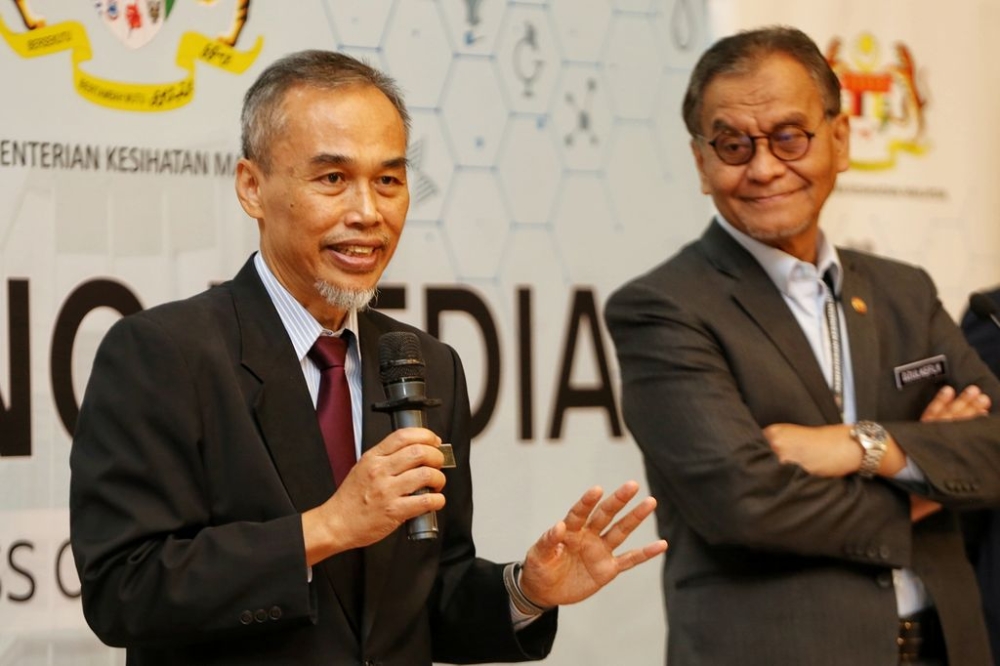KUALA LUMPUR, Jan 28 — A seasoned clinical geneticist suggested prioritising healthcare equity over equality, citing that while crowdfunding helps with immediate needs, especially for Malaysia’s rare disease community — it is not a sustainable solution due to high medical expenses.
“Equality is not the same as equity. People tend to associate them as being the same,” Dr Thong Meow Keong, a Professor of Paediatrics and Consultant Clinical Geneticist at the University of Malaya Medical Centre, told Malay Mail in a recent interview.
“Equality means everybody gets the same amount of funding in healthcare.
“Meanwhile, equity means distributing resources based on an individual’s condition. For example, the treatment of some illnesses for the majority of patients may not need a huge allocation while a minority of patients may need thousands or millions of ringgit for the life-saving treatment.
“If everybody is allotted the same amount of healthcare funds, the patient with a simple viral infection may be treated with ‘fever medication’ and bed rest but patients with a serious genetic condition may need millions of ringgit for gene therapy.
“If we prioritise equality over equity in healthcare, many patients with serious genetic conditions may be overlooked or not be treated,” he explained.

Currently, the world’s most expensive drug, “Zolgensma,” is priced at over US$2 million (RM9.30 million) per dose and is used for the treatment of the rare disease Spinal Muscular Atrophy (SMA).
Cases of non-communicable diseases (NCDs) like obesity-related conditions such as diabetes mellitus and hypercholesterolemia and ‘lifestyle’-related diseases such as lung cancer are increasing, with an increasing number of patients every year needing millions for treatment, and resources are allocated to this group, while infants and adults with genetic diseases which are also NCDs — lack similar financial support, Dr Thong said.
“Although each rare disease (RD) is individually rare, collectively they number over 7,000 types and the RD community makes up 5–8 per cent of the population. We need equity in healthcare for rare diseases so that we leave no one behind,” he asserted.
This is in keeping with the recent announcement of the global rare disease community call on United Nations Member States to turn Universal Health Coverage into a reality for people living with rare diseases (PLWRD).
Approaches to rare disease control
Dr Thong, who is also an advisor to the Malaysian Rare Disorder Society (MRDS), pointed out that crowdfunding for major illnesses is typically a one-time effort, only enough for a single treatment or one patient. Yet, certain chronic rare diseases demand lifelong treatment.
Even so, he said treating rare diseases involves more than medication, as other approaches such as genetic counselling, surgery, rehabilitation, speech therapy, physical therapy, and occupational therapy are also effective.
To counter and control any rare disease, he said public health efforts should be made simultaneously in four aspects: Awareness and education of the healthcare professionals and members of the public, having a rare disease registry and adoption of preventive strategies, accurate and timely diagnosis, and early treatment and rehabilitation, rather than relying solely on medication alone.
According to data from the Malaysian Rare Disorders Society, 75 per cent of rare disease patients are children.
As Malaysia had signed as a signatory and ratified the Unicef Convention on the Rights of the Child, Malaysia is obligated to ensure children have access to the best healthcare, clean drinking water, healthy food, and a clean and safe environment to live in.
“And yet, do we provide all the medicines that the child needs to survive and get well so that he or she can be a useful and productive citizen of the country in the future?”
Rare diseases are non-communicable diseases
Rare diseases, despite being non-communicable diseases, are omitted from the Ministry of Health’s National Strategic Plan for Non-Communicable Diseases (NCD) 2016-2025.
Dr Thong noted that the plan has solely gathered population data for those aged 15 and above with non-communicable diseases.
Some rare diseases, unlike lifestyle-induced non-communicable diseases, are congenital, he said.
“The use of tobacco and excessive intake of salt, calories and sedentary lifestyle lead to chronic respiratory diseases and lung cancer and obesity, hypertension, diabetes mellitus, respectively.
“All these are lifestyle diseases and priority is given to them for treatment as outlined in the National Strategic Plan for NCDs. On the other hand, congenital or rare diseases may occur to anyone, regardless of gender, race, age, socioeconomic status and geographic areas of birth but scant attention is given to these life-threatening conditions.
“Every year, hundreds of children succumb to congenital rare diseases. Many were undiagnosed and did not receive proper counselling. This issue is seldom brought up because children have no voice. The saddest part is the deaths of Malaysian children under 5 years of age had remained static over the past 20 years as reported in the Health White Paper 2023,” he said.
Most rare diseases are related to genetics
Dr Thong noted that 80 per cent of rare diseases stem from genetics, with the remaining 20 per cent usually caused by environmental factors or a mixture of genes and environment.
All women of childbearing age are encouraged to consume folic acid 400 microgram daily at least one month before conception to reduce the risk of neural tube defects by 60 to 70 per cent.
“Environmental factors such as pollution, chemicals, viruses, and certain drugs, such as the substance abuse of fentanyl may cause harm to a developing fetus.
“If the pregnant ladies use fentanyl, there is a high chance that the child will be affected as well. And it will be classified as a rare condition,” he said.

Health Ministry’s progress on track
The Health Ministry implements the Malaysia Rare Disease Strategic Plan in three phases: Short-term (2020-2021), mid-term (2022-2023), and long-term (2024-2030), with both short-term and mid-term plans achieving the expected goals.
In a written response to Malay Mail, Health Director-General Datuk Dr Muhammad Radzi Abu Hassan highlighted the short-term plan’s achievements, encompassing the establishment of a standard definition for rare diseases, compilation of a Malaysia Rare Disease List based on ICD-10 (Tenth revision of the International Classification of Diseases) and specified criteria, and formulation of the Malaysian Orphan Medicines Guideline to streamline orphan drug registration and import procedures.
“The mid-term plan’s achievements include the drafting of a written policy on rare diseases based on the Health Ministry’s National Strategic Plan for Medical Programmes, with the expectation that this draft will be finalised by early 2024, ongoing efforts to update the Malaysia Rare Disease List based on ICD-11 (Eleventh revision of the International Classification of Diseases), the establishment of a Rare Disease Trust Fund at Hospital Tunku Azizah Kuala Lumpur in 2022, and the establishment of the Malaysia Rare Disease Database, which is still in the refinement stage,” he explained.
As for the long-term plan, Dr Muhammad Radzi said the Health Ministry is committed to providing continuous care for rare disease patients through comprehensive service management and treatment.
Additionally, he said that other efforts include refining the “Rare Disease Management Strategic Plan”, encouraging research and development in the rare disease field, proposing collaborations with insurance companies, and ensuring that existing laws safeguard the rights of rare disease patients.
Ministry’s key challenge
As per the records, the allocated funding of RM25 million for treating rare diseases has benefited 60 patients.
Dr Muhammad Radzi highlighted the cost of treatment as the key challenge for the Health Ministry in addressing rare diseases.
“For example, the annual treatment cost for a paediatric patient ranges from RM500,000 to RM1 million, which includes expenses for medications such as Enzyme Replacement Therapy (ERT).
“The treatment cost for ERT increases with the patient’s age, as the medication dosage is determined based on the patient’s weight.
“Since ERT is a continuous treatment, it must not be interrupted as complications may recur,” he explained.
He said upon initiation of ERT, it is essential for patients to commit to lifelong treatment.
Providing another example, he explained that Spinal Muscular Atrophy (SMA) patients undergoing Spinraza gene therapy incur a first-year treatment cost of US$750,000 (RM 3.1 million), followed by an annual cost of US$375,000 (RM 1.56 million).
For SMA patients receiving Zolgensma, he said that the treatment cost is US$2.125 million (RM 8.87 million).
He explained that Zolgensma is a one-time gene therapy, where eligible SMA patients only need a single intravenous injection of the medication. However, the treatment is expensive.
He said that the Health Ministry will offer treatment based on the conditions of rare disease patients.
“Some patients only need diagnostic tests and supportive therapy as there is no specific treatment available yet. Some need special milk treatment, while others require specific medications. We also provide physical therapy, occupational therapy, and more for patients with specific needs,” he added.
Insurance coverage
A random verification shows that many rare diseases listed in the Malaysian Rare Disease List are not covered by several life insurance companies.
Out of the 492 rare diseases listed in the Malaysian Rare Disease List, only Multiple Sclerosis, Muscular Dystrophy, Systemic Lupus Erythematosus (SLE), Severe Aplastic Anaemia, and Cardiomyopathy are covered by Great Eastern Insurance, confirmed by Aaron, a life planning advisor at Great Eastern Insurance.
It is noted that within the Malaysian Rare Disease List, Muscular Dystrophy is further refined into Congenital Muscular Dystrophy, Duchenne Muscular Dystrophy, Facioscapulohumeral Muscular Dystrophy, Becker Muscular Dystrophy, and Limb-girdle Muscular Dystrophy.
In general, local insurance companies allow claims whenever the diagnosis confirms that the insured person has a critical illness covered by the policy, provided that the specified terms and conditions are met.
According to life planner Jamie Ooi, for critical illness insurance claims, the diagnosed disease must be listed in the policy.
For standard medical insurance (medical card), reimbursement for reasonable inpatient treatment is granted if the insured truthfully reports their health during the application, passes underwriting and approval, and completes a 120-day waiting period, she added.
How can the public help?
The Rare Disease Trust Fund, established by the government in July 2022, aims to streamline donations from various contributors.
As of July 2023, the Rare Disease Trust Fund has accumulated a total of RM105,000 in donations, said the health director-general.
“Among more than 20 associations in the rare disease community, only the Malaysia Lysosomal Diseases Association (MLDA) actively fundraises, directing proceeds into the Rare Disease Trust Fund to ensure ongoing access to treatment funds for patients,” Dr Muhammad Radzi said.
The public is encouraged to support the rare diseases community by making contributions to the Rare Disease Trust Fund, he added.
In the Budget 2023 tabled by then Finance Minister Tengku Datuk Seri Zafrul Tengku Abdul Aziz, individuals contributing to the Rare Disease Trust Fund are entitled to tax exemption for their donations.
** This is part two of a feature story supported by the US National Press Foundation’s 2023 Covering Rare Diseases fellowship.




















